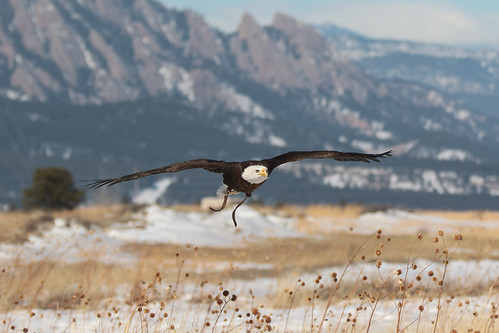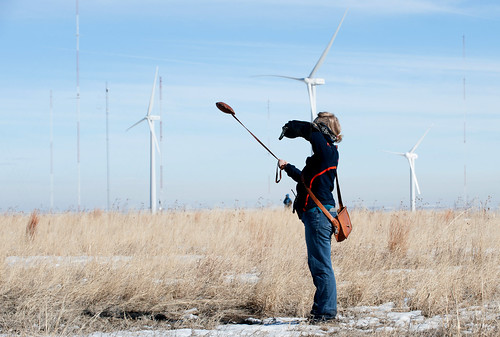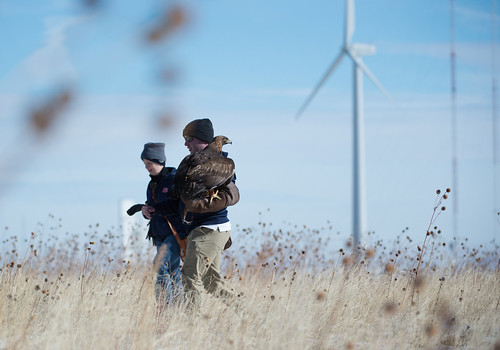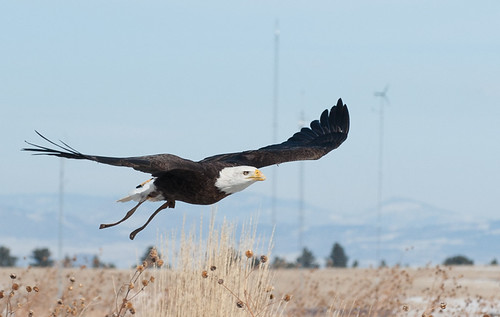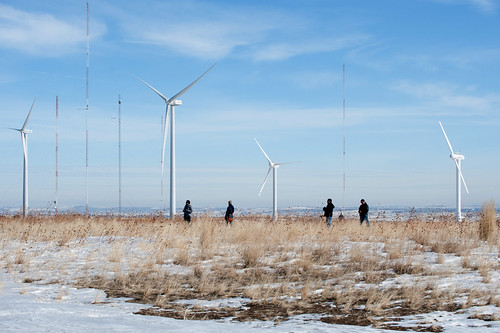Auburn's eagles participating in Colorado wind technology research to help prevent bird strikes
Article body
The Auburn University eagles, trainers and a veterinarian are in the Colorado Rockies, participating in research to help the U.S. Department of Energy's National Renewable Energy Laboratory develop a radar system to prevent bird strikes in wind turbines.
Golden eagle Nova (War Eagle VII) and bald eagle Spirit are participating in strategic flights at the National Wind Technology Center at the Colorado laboratory along with Southeastern Raptor Center trainers Marianne Hudson and Andrew Hopkins and avian veterinarian Dr. Seth Oster, an assistant clinical professor in Auburn's College of Veterinary Medicine.
Bird collisions with wind turbine blades are uncommon, but since birds can fly at the height of the huge blades, anything that can be done to protect them is important. Golden eagles, protected under federal law, are among the large birds that could interact with wind turbines.
"These eagles are an important part of the Auburn Family and have given much joy to game day fans and participants in our local educational presentations," said Hudson, assistant director of education and raptor training at the Southeastern Raptor Center. "This is an opportunity for these birds to potentially make an even bigger impact by providing data that may save the lives of their wild brethren worldwide."
While participating in the research, both of Auburn's eagles will wear sophisticated GPS tracking and logging devices as they do each time they fly in Jordan-Hare Stadium, which will provide constant monitoring of their location.
In 2009, the National Renewable Energy Laboratory partnered with Laufer Wind to test the company's Aircraft Detection System, a radar-based system designed to detect nearby planes and automatically switch on and off aviation warning lights on the turbines to forewarn pilots. That capability is important because otherwise the lights have to be on all the time after dark, which creates a visual nuisance to surrounding communities, impedes wind development and negatively impacts wildlife.
After success with that system, researchers from Laufer Wind and the laboratory turned their attention to testing the radar system's capabilities to detect birds, said Ismael Mendoza, who at the time was laboratory's project leader. The alternative -- mandated in many places – is to station a person at the wind power plant 24 hours a day, seven days a week, to watch for birds.
Laufer Wind was able to join in research being conducted by the University of Colorado, which has permission from the Federal Aviation Administration to fly drones at the National Wind Technology Center. As the radar scans 360 degrees, it picks up the drone in a small slice of that circle. The radar can use detections from each rotation to track the drone. Since those early drone flights, the research shifted to using live birds with GPS loggers to directly test the avian detection systems.
"They're looking for a needle in a haystack," Roadman said. "The radars process a gigabyte of data every minute; the trick is to discern the bytes of data that represent the bird. Learning the size, speed and flight characteristics of the eagle helps the radar determine what is and isn't a bird."
The aim is to detect birds soon enough so an alert can be sent to the wind power plant operator in time to shut down the blades.
Unlike the radar technology, IdentiFlight is a visual eagle detection system. Renewable Energy Systems, a leading wind developer and constructor, along with Boulder Imaging, machine vision experts, have developed a system of cameras that detects raptors at up to 1,000 meters – or 0.62 miles – from a wind turbine. At this distance, there is time to determine with certainty the identity of the eagle in time for the wind turbine to come to a slow stop and protect the eagle from collision with the rotating blades.
"As a nation, we need more sources of clean energy, such as wind power. Providing technologies enable wind energy projects and wildlife co-exist is how IdentiFlight came to be," said Tom Hiester, president of IdentiFlight. "Through the test with Auburn University, we can further understand eagles and build on our computer algorithms that use size, shape, color and flight characteristics to identify species of concern."
Related Media
Media interested in this story can contact Communications Director Preston Sparks at (334) 844-9999 or preston.sparks@auburn.edu.
Auburn University is a nationally ranked land grant institution recognized for its commitment to world-class scholarship, interdisciplinary research with an elite, top-tier Carnegie R1 classification, life-changing outreach with Carnegie’s Community Engagement designation and an undergraduate education experience second to none. Auburn is home to more than 30,000 students, and its faculty and research partners collaborate to develop and deliver meaningful scholarship, science and technology-based advancements that meet pressing regional, national and global needs. Auburn’s commitment to active student engagement, professional success and public/private partnership drives a growing reputation for outreach and extension that delivers broad economic, health and societal impact.



